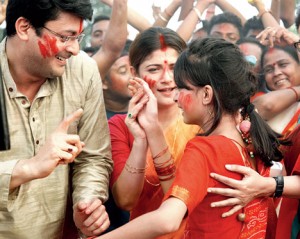
By Devapriya Sanyal.
Uma is Srijit Mukherji’s twelfth film in seven years. It is based on a real story, which by the director’s own admission he found on Facebook. He then set about writing a story based on the Bengali festival of Durga Puja, with an eponymous heroine, for Uma is the other name by which the goddess Durga is invoked.
Uma is the symbol of power in the Hindu mythology, who singlehandedly vanquished the demon Mahishashura and restored heaven to the gods who had been banished from their abode by the demon. Srijit’s Uma however just touches on the fringes of this lore. In his story Uma is a young girl who lives somewhere in the picturesque Switzerland with her single parent, her father Himadri, who also doubles up as her mother.
As the story progresses we find that Uma has a deep desire to be a part of the Durga Puja festivities in the city of Kolkata (numerous stories of which she has heard from her father; she also hopes to meet her mother who left them when Uma was two years old). Uma is terminally ill and may not survive until October when Bengalis celebrate the festival. Rooted in the father’s deep desire to create an early Durga Puja in March and make his daughter’s last wish come true, the father at first travels to Kolkata to set up the Durga Puja in the month of March. Here he meets with some opposition, as this sounds ridiculous to a lot of people. But finally, with the help of a film producer, a director and his team, Himadri brings to fruition the Durga Puja.
 From a simple tale of a father and daughter the canvas enlarges to include Brahmananda Chakravarty, a successful failure of a film director who comes on board to create the illusion or rather this dream project. He is someone who has suffered material losses for being unable to move with the times as far as his cinema was concerned, and also emotionally, as his wife leaves him with their only son in tow. However he is the only one who can actually make Uma’s dream come true. Here’s also another example of Srijit’s penchant for playing with names. Brahmananda is actually Lord Brahma – the creator in Hindu mythology. Himadri is another name for the Himalayas. Arka Roy, Brahmanda’s cinematographer, is named after the sun god, cinematography being an art which requires the medium of light or rather is the play of light, and so on and so forth.
From a simple tale of a father and daughter the canvas enlarges to include Brahmananda Chakravarty, a successful failure of a film director who comes on board to create the illusion or rather this dream project. He is someone who has suffered material losses for being unable to move with the times as far as his cinema was concerned, and also emotionally, as his wife leaves him with their only son in tow. However he is the only one who can actually make Uma’s dream come true. Here’s also another example of Srijit’s penchant for playing with names. Brahmananda is actually Lord Brahma – the creator in Hindu mythology. Himadri is another name for the Himalayas. Arka Roy, Brahmanda’s cinematographer, is named after the sun god, cinematography being an art which requires the medium of light or rather is the play of light, and so on and so forth.
In the sequence involving Himadri’s request to Bramhananda, Srijit inserts the hopeless director’s back story in a neat way. However, Srijit becomes a bit didactic in his approach to cinema about which he comes across as passionate and seems to worship. For this he chooses Brahmananda’s guru as his mouthpiece. As in all of Srijit’s films, most of them blockbusters, faint autobiographical echoes come wafting through his dialogue – “The story is true above everything else,” “Don’t ever give up on the opportunity of telling a story,” “Even if it’s just one audience member you should still carry on telling the story.”
A little over three fourths of the film includes the trope of a film within a film. So a whole sequence is based on telling his audience what the art of film-making actually entails (all technical details of course, such as the function of the DOP, the art director, the role of the AD, nothing philosophical here though).
Simultaneously, more characters begin crowding the mise-en-scène and there is a danger of the sheer number of characters overwhelming the tale which had begun on such a simple note.
As Brahmananda along with his team set out to create this Durga Puja in March, an ugly spat between a conservative Hindu, Mahitosh Sur, and the team ensues, which seems resolved as Brahmananda evokes the myth of the untimely Durga Puja, the ‘Awkal Bodhon’ of Hindu mythology, performed by Lord Ram when he set out to destroy the demon king Ravana. But Mahitosh Sur is not someone who gives up easily and decides on other means to sabotage Uma’s Durga Puja.
 In one scene, the director himself makes a splendid appearance as something of a tongue in cheek caricature of the archetypical Indian cinema villain. After Himadri breaks his nose, this villain relents and participates in the charade of an untimely Durga Puja. A local goon is called in by Mahitosh, more obstacles are created for the team, but again justice prevails and in a succinct way the director tells the audience about the goon’s reluctance to sabotage the festivities because he too has a teeny weeny back story of which we have a glimpse. Finally, despite of the many difficulties faced by team Brahmananda and Himadri, the Durga Puja is celebrated and the young girl fooled into believing that this is indeed a very genuine Durga Puja, although taking place in the month of March.
In one scene, the director himself makes a splendid appearance as something of a tongue in cheek caricature of the archetypical Indian cinema villain. After Himadri breaks his nose, this villain relents and participates in the charade of an untimely Durga Puja. A local goon is called in by Mahitosh, more obstacles are created for the team, but again justice prevails and in a succinct way the director tells the audience about the goon’s reluctance to sabotage the festivities because he too has a teeny weeny back story of which we have a glimpse. Finally, despite of the many difficulties faced by team Brahmananda and Himadri, the Durga Puja is celebrated and the young girl fooled into believing that this is indeed a very genuine Durga Puja, although taking place in the month of March.
At the end, the humane side of everyone triumphs as every friend and foe comes together (the execution is neat but seems a tad bit sentimental) and good triumphs over evil (as the myth of Devi Durga goes). Srijit too triumphs in telling a successful story as the film became a blockbuster. Through his cinema Srijit tries celebrating Kolkata, “the city of joy,” according to the phrase made famous by Dominique Lapierre. Though it was in Kolkata that Himadri first encountered opposition to fulfill his dying daughter’s last wish, in the end it is Kolkata and its citizens who come together to celebrate happiness and love. No mean achievement this.
Srijit Mukherji has acquired a significant fan following. His cinema is a happy mixture of art house and commercial Bangla cinema, in which storytelling triumphs (in this he is a bit like Satyajit Ray). With him, the genre of New Bhadralok Cinema has found a new home, as he continues to build on its tradition of “quality” (mostly borrowing its stories from the rich treasure trove of Bengali literature), while following in the footsteps of the middle class Bangla cinema of such giants as Satyajit Ray, Ritwik Ghatak and Mrinal Sen. At the same time, Srijit’s cinema reflects larger trends in Bengali society and culture, appropriating as well the production techniques, aesthetic criteria and narratives of New Bollywood cinema.
Like his cinema, Srijit the director must be celebrated because he belongs to a line of directors who have weaved magic in the formidable Bengali cinema tradition, alongside Ray, Ghatak, Mrinal Sen and, later, Aparna Sen and Rituparno Ghosh. The former three went on to influence the Parallel cinema movement of Shyam Benegal, Govind Nihalani and others, who strove most successfully against the onslaught of commercial Hindi cinema in the 1970s and the 80s.
Finally, Srijit’s other strong point, besides a solid storyline, impeccable direction, and camera work, is his emphasis on good music. Here you have a titular song that sings of “Uma,” the eponymous heroine, which is soul stirring to say the least.
Devapriya Sanyal has a Ph.D. in English Literature from JNU, India. She is the author of From Text to Screen: Issues and Images in Schindler’s List and Through the Eyes of a Cinematographer: A Biography of Soumendu Roy (Harper Collins, 2017).
